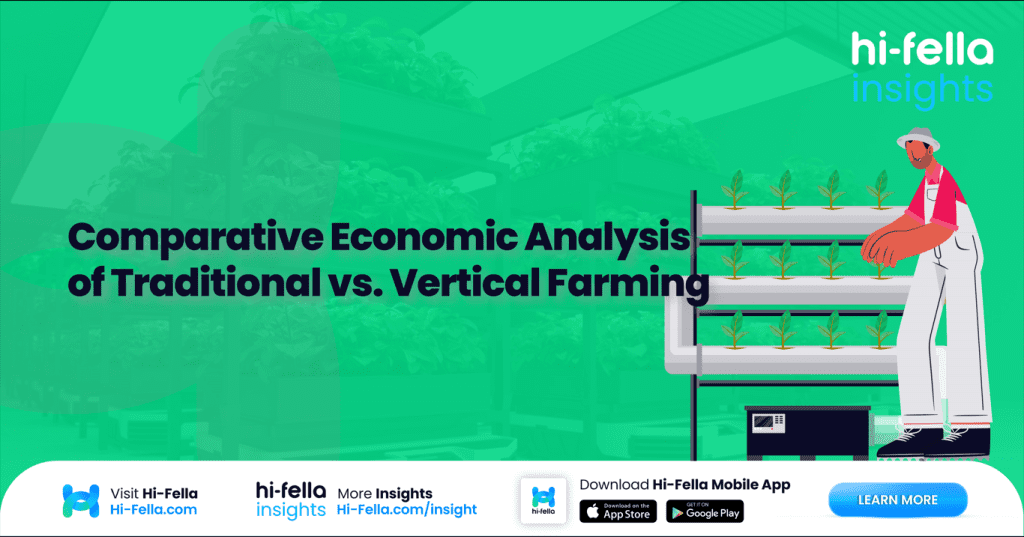Farming isn’t just about growing food anymore—it’s about growing smart. As urbanisation accelerates and arable land shrinks, agriculture has started to evolve into a high-tech arena. Enter vertical farming: the cool, clean, and climate-controlled cousin of traditional agriculture. But when it comes to economics, how do these two farming methods stack up?
Let’s break it down and look at the economics from the ground up—literally and vertically.
Land Use and Infrastructure Costs
Traditional farming thrives on wide-open fields. It requires vast tracts of arable land, which comes at a premium—especially near urban centres. The cost of acquiring or leasing agricultural land is often one of the biggest barriers to entry for new farmers.
Vertical farming flips this challenge on its head. It compresses agriculture into stacked layers inside warehouses or specially designed buildings. Yes, the startup costs are significant—think LED lighting systems, climate control, hydroponics or aeroponics, and automated monitoring—but it slashes the need for expensive rural acreage. And because vertical farms can be set up in urban areas, they drastically cut transportation and distribution costs too. Over time, the ROI starts to look pretty attractive.
Yield and Productivity
Traditional farming is at the mercy of nature. Crop yields depend on weather, soil quality, pests, and seasonal cycles. Even with mechanisation and agrochemicals, you’re still dealing with a lot of variables. That’s a risky business model.
Vertical farming, meanwhile, is the perfectionist’s dream. It controls every variable—light, temperature, humidity, CO₂ levels—so crops grow faster and more consistently. A vertical farm can produce 10–20 times more food per square metre than a conventional farm, all year round. That kind of productivity isn’t just a win for food security—it’s a win for investors too.
Labour and Automation
One of the biggest economic shifts in vertical farming is how labour is used. Traditional farming still relies heavily on manual labour for planting, harvesting, irrigation, and pest control—especially in developing countries. Labour costs can be volatile, depending on regulations and availability.
In contrast, vertical farms are basically green tech labs. Automation handles most of the heavy lifting, from nutrient delivery to harvesting. Sure, you’ll need skilled workers to manage systems and troubleshoot tech—but you’ll need far fewer of them. That means lower long-term labour costs and more efficiency per unit of output.
Water and Resource Efficiency
Water is a big-ticket item in traditional farming. It guzzles about 70% of the world’s freshwater supply, and inefficient irrigation leads to a lot of waste.
Vertical farming is stingy in all the right ways. Thanks to hydroponic and aeroponic systems, it uses up to 95% less water than traditional farming. Plus, since the water is recirculated and monitored precisely, you avoid overuse and runoff entirely. In regions facing water scarcity, that’s not just eco-friendly—it’s economically transformative.
Energy Costs and Sustainability
Here’s where vertical farming hits a snag: energy consumption. Those glowing LED lights and climate control systems aren’t cheap. Energy costs can account for a large portion of operational expenses, especially in regions where electricity isn’t subsidised.
Traditional farming, by comparison, mostly relies on free natural resources—sunlight, rain, wind. But its carbon footprint is larger, thanks to heavy use of fossil-fuel-powered machinery, chemical inputs, and long-distance transportation.
The trade-off? Vertical farms are easier to power with renewables and emit fewer greenhouse gases. Over time, with improvements in LED efficiency and solar integration, energy costs could stabilise and even tilt the economic equation in favour of vertical systems.
Supply Chain and Market Proximity
Traditional farms are often located far from urban centres. That means longer supply chains, more intermediaries, and more food loss along the way. It’s a classic case of decentralised production meeting centralised consumption.
Vertical farms, on the other hand, can be built right where people live—in the middle of cities. That means faster delivery, fresher produce, fewer logistics headaches, and a closer connection to end-users. For businesses looking to streamline operations and reduce spoilage, that’s a huge economic advantage.
Crop Variety and Market Limitations
Traditional farms can grow a wide array of crops—grains, tubers, fruits, vegetables—depending on the climate and soil. They’re also better equipped for large-scale commodity production, like wheat or maize, which are central to the global food system.
Vertical farms currently focus on high-margin, fast-growing crops: leafy greens, herbs, microgreens, strawberries. That’s great for boutique grocers and urban consumers, but it doesn’t yet scale for staples. So, if you’re targeting volume and variety, traditional farming still has the upper hand in some areas.
Investment Horizon and Risk
Traditional farming is familiar territory for investors, but it’s also subject to high risks—climate change, pests, fluctuating commodity prices. Crop failure can wipe out profits in a single season.
Vertical farming is high-risk, high-reward. The initial capital outlay is heavy, but once a system is optimised, it’s extremely resilient. The ROI depends on efficient tech, crop selection, and market strategy. For investors willing to play the long game and bet on sustainable innovation, vertical farming has massive potential upside.
Policy Incentives and Funding
Governments around the world are beginning to see vertical farming as a path to food resilience. As a result, funding, grants, and tax incentives are growing—especially in countries concerned with urban food access and climate adaptation.
Traditional farmers still receive subsidies too, but they’re often tied to commodity crops or outdated models. In terms of future-proofing policy, vertical farming has momentum.
The Economic Bottom Line
So, which one wins economically? The answer isn’t binary.
If you’re growing massive quantities of staple crops on existing land, traditional farming still offers better short-term returns with lower startup costs.
But if you’re focused on sustainability, urban markets, and future scalability—vertical farming is where the economic and environmental trends are pointing. Especially as technology advances and energy becomes cleaner, the cost gap will continue to narrow.
Both systems have their place. The smart move is recognising when and where each model makes economic sense—and how they can complement each other in building a more resilient food ecosystem.
Time to Think Smarter
We’re no longer living in a world where one farming method rules them all. Whether you’re a policymaker, entrepreneur, or just someone who wants to eat sustainably grown arugula in your city loft, it’s clear that vertical farming isn’t just a sci-fi fantasy—it’s an economic contender.
Thinking of diving into the future of farming or building something impactful in the agri-tech world? Let’s make sure you’re working with the right tools, networks, and communities. Start your journey today with hi-fella—where bold ideas meet smart solutions.








